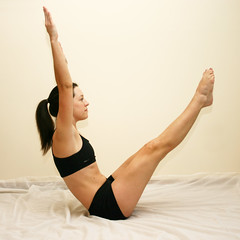Friday, November 9, 2012
Fitness Friday: "Modify" is NOT a Dirty Word
The above is what I think I look like doing Pilates.
But a lot of times, I suspect this is what I actually look like:
How to get from here to there? Modify!
"Modify" almost seems like a dirty word in exercise. A concession. A cop out.
But it's not - or at least it doesn't have to be! The right modifications can be a gateway to a more difficult move that may be intimidating all on its own. Or they can make a workout accessible during recovery from injury or illness (of course, check with your doctor first!).
What brought this subject to mind this week was doing some tough ab/core work as part of my October-in-November Blogilates Challenge. I'll confess that I dread lower ab work to begin with, and after my recent downtime, I was feeling the work (i.e. pain) in my low back more than in my abs. Cassey suggested a few perfect modifications that enabled me to get through the routine, get a great burn, and finish feeling accomplished rather than deflated.
So today I'm sharing some of my favorite modifications. Try these suggestions to help you climb your way to the next level of fitness.
1) Burpees - Burpees or squat thrusts are a GREAT cardio move and feature heavily in a lot of HIIT (high intensity interval training) workouts. Because they're so effective, they're also really, really TOUGH! Rather than jumping head-first, try modifying by stepping back instead of jumping back into plank, as demonstrated in the below video. It will help you avoid injury (and nagging defeatist feelings).
A different burpee modification I've used is to place my hands on a tall step or chair seat instead of taking them all the way to the ground. By keeping your head above the level of your heart, it's a little less shocking on that cardiovascular muscle.
2) Corkscrew - the Pilates corkscrew is a fantastic move to work the lower abdominal muscles. It can be tough on your low back when you're starting out (or restarting, ahem). Bending your knees (shown in the below, full-length ab routine at 00:42) takes the pressure off of the low back and hip flexors while still torching the low abs!
A more general lower ab modification is to place your hands under your glutes to give your low back a break while you're building that lower ab foundation.
3) Slow down - across the board (from mountain climbers, to Pilates roll-ups), when my fitness level is not up to par, simply taking things at my own pace can see me through the tough spots in a workout. Learn to temporarily tune out an instructor's count, and concentrate on form. You may only get seven repetitions done in the time it takes her to do 10, but you can still get a great workout, protect yourself from injury, and improve over the long run so you no longer have to slow down or otherwise modify.
The key is to use modifications either as an entree to a tough, new move, or when your body needs a break, and then up the ante by doing the full version when you're ready rather than resting on your laurels.
What are your favorite ways to modify and still get a great workout?
Image credits: Toni Busch (perfect Pilates); Valerie "ucumari" (Pilates Bear)
Labels:
Fitness Friday
Subscribe to:
Post Comments (Atom)


Yes, I agree with you completely about modifying. Sometimes I just realise that I'm glad to be exercising at all, regardless of whether I am the most advanced in the group. Or when I run I give myself some freedom to cut the run short from time to time when I feel bad - because I think that persisting with the habit is more important than always following the plan exactly. Plus, "no matter how slow (or short) you run, you are lapping everyone on the couch." :)
ReplyDeleteYou're so right, Sarah! At least, even on short-workout, heavily-modified days, I'm ahead of where I'd be if I'd stayed on the couch or in bed!
DeleteLove the comparison (though I'm sure you don't look like a bear). I've become a fan of Bar Method and I'm pleasantly surprised by how many modifications they offer in the class, and lots of props for support, even though the instructors are all these stretchy dancer-types. Turns out the method was developed in consultation with PT's, which is why it's so modification-friendly. I think what gets in the way of doing safe modifications is ego or competitiveness.
ReplyDeleteAileen, so funny that you mention Bar Method - I have a few of their videos and just learned they opened a studio about 5 mi. from my house. You make it sound like it's definitely worth a try, even if I'm feeling like a "work in progress" at the moment.
Delete